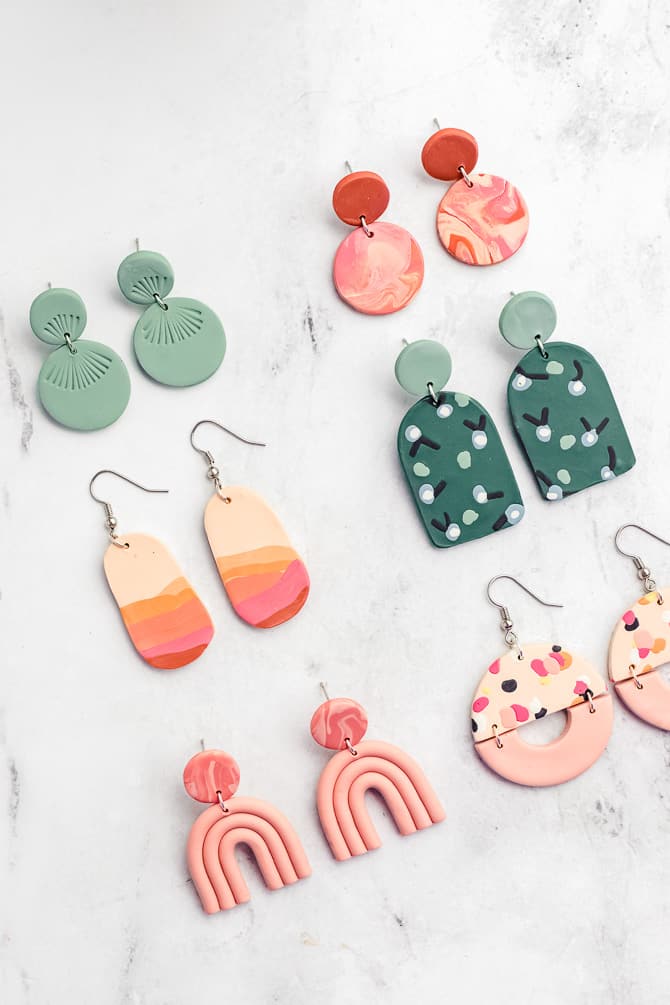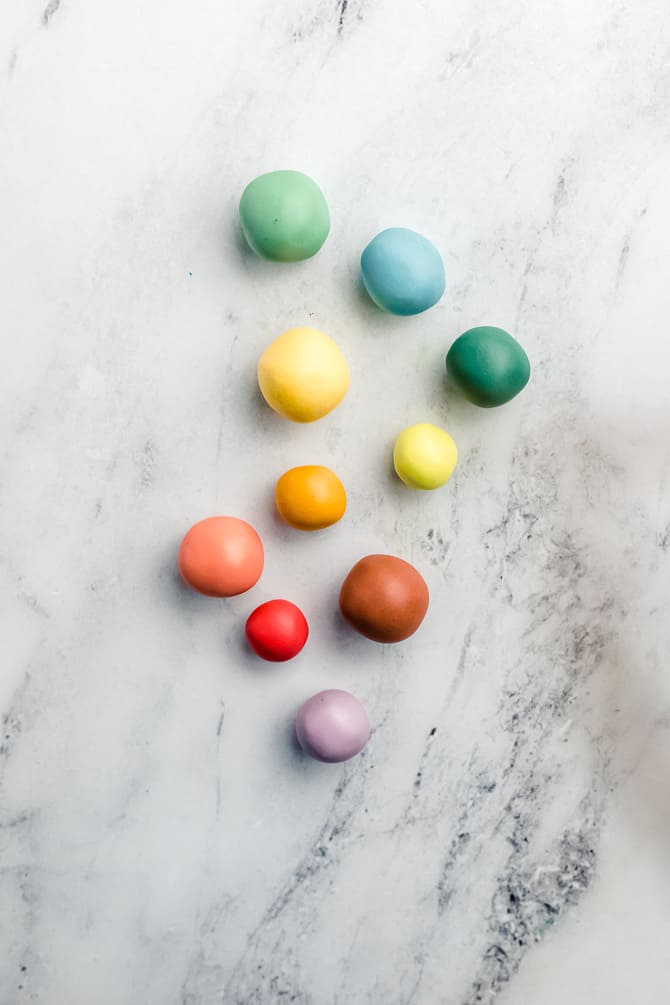How Do You Know When Polymer Clay Is Done Baking
Polymer clay is a versatile product that can exist used for many things, from jewelry to home décor. If you've never baked polymer clay before, this weblog mail service volition tell yous how to do it the correct manner! In this footstep-by-step tutorial, I'll walk yous through every particular of how to bake polymer clay for perfect results every time.

I love crafting with polymer dirt. I find information technology so relaxing and rewarding to make things from this material. Information technology is also very versatile, as you can utilise the aforementioned basic techniques for different projects – such equally clay earrings and other jewelry, dwelling house decor, charms, ornaments, and more.
The only question has been how to bake polymer clay for best results! Baking polymer clay in an oven is not as foolproof as it sounds. The right temperature, the right amount of time – all these details thing when baking polymer clay.
How to Bake Polymer Clay
Fix to broil your latest polymer clay projection? In this blog post, we will discuss a few different ways to bake your clay for the all-time results.
I'll share my tips and tricks to ensure that your polymer clay creations come out perfect every fourth dimension! And, I've included detailed instructions on what temperature and how long to bake all types of polymer clay projects.
The Best Way to Bake Polymer Clay
The best way to bake polymer dirt is to use an oven. Yous can use your regular home oven – it's perfectly safe. You don't need to purchase a defended clay oven or kiln.
If you don't have a regular home oven, you can utilise a toaster oven. If you want to use a toaster oven, choose a model that tin hold a steady, authentic temperature — we'll talk about this more below.
Next, gather your materials and tools. You volition demand a baking canvass, some aluminum foil, a canvas of parchment newspaper, and an oven thermometer. And, of course, you lot will demand your clay project.
Pace 1: Read the parcel direction to detect out what temperature and fourth dimension your make recommends. Place the oven thermometer onto the heart rack of the oven, and preheat your oven to the correct temperature.
Step ii: When the oven has finished preheating, check your oven temperature on the oven thermometer. All ovens are different, and virtually are not 100% accurate, so it's a adept idea to test the temperature before blistering. If you find your oven is too hot or besides cold, adjust the temperature. Wait again for the oven to preheat.
Step three: Set your projection for baking. Line a flat baking canvass with parchment paper. Carefully place your projection onto the parchment paper. Comprehend the clay with a tented piece of aluminum foil (or cover it with an upside-downwardly baking pan).
Step 4: Bake your clay at the recommended temperature for at to the lowest degree the recommended amount of time. In general, you can bake polymer dirt at 275F for about thirty minutes per 1/4 inch of thickness.
That said, always refer to the package instructions for brand-specific directions. (Here are some of my favorite brands of polymer clay.)
#1 Tip: Don't underbake.
I know that a lot of people are afraid of baking their projects for too long considering they don't desire to burn their clay. Merely, let me reassure yous: if you are using the correct temperature (verified by an oven thermometer), you won't have whatever problems with burned dirt.

More than Tips about Blistering Polymer Clay
Now that we've covered the best fashion to bake polymer dirt, let's talk near some of the specific questions people take about blistering polymer dirt.
Types of Ovens
How to bake polymer clay in a regular oven
To bake polymer dirt in a regular home oven, follow the direction outlined higher up.
One of the best things y'all tin can do to ensure good results is to test your oven temperature with an oven thermometer. Oven thermometers similar this one are inexpensive and widely available.
You demand to test your oven temperature considering most ovens run either too hot or too cold. If you bake at too hot a temperature, your project could become discolored or burned. If you bake at too low a temperature, your project will never fully cure.
How to bake polymer clay in a convection oven
You can as well use a convection oven for baking polymer clay. Convection ovens are especially squeamish because they have a fan inside that circulates the heat and prevents "hot spots." That will help your polymer dirt projection to bake evenly without discoloring.
The procedure of baking with a convection oven will be almost the same as using a standard oven.
- Preheat the oven to 275 degrees Fahrenheit.
- Check your oven temperature with an oven thermometer, and adjust the temperature as needed.
- Line the flat baking sheet with a piece of parchment paper, and place the project on top.
- Here, I would typically tell yous to tent the project with a folded piece of aluminum foil – but this might get blown around by the fan. So instead, apply an upside-down baking pan to encompass your project.
How to bake polymer clay without an oven
If yous don't have access to an oven, you can bake polymer dirt with a toaster oven.
Blistering polymer dirt in a toaster oven
Using a toaster oven to bake polymer clay can be trickier than using a regular oven. Depending on your toaster oven's size, age, and model, it might not hold a consistent, accurate temperature. Also, because of the smaller size, the clay project may be also shut to the heating elements, leading to scorching.
So, if you lot are using a toaster oven, be extra careful with the temperature. And, be sure to comprehend your dirt pieces with foil or an upside-down baking pan.

Can you broil polymer clay in a microwave?
No, exercise non attempt to microwave polymer clay. Microwave ovens don't create the right kind of heating environment for curing polymer dirt. Microwaving your projection will only lead to burned clay and disappointment.
Can y'all bake polymer clay in an air fryer?
I suppose since an air fryer is, substantially, a small convection oven, it might exist possible to broil polymer dirt in an air fryer. That said, you would demand to do a lot of testing to ensure that your specific model can maintain an accurate, consistent temperature to cure the clay without scorching.
In general, I'd avoid it.
Types of Baking Surfaces
Y'all can bake clay on a variety of surfaces, including foil and paper.
Baking polymer clay on aluminum foil
The just problem with baking clay on aluminum foil is that the shiny surface of the foil tin can exit shiny spots on the underside of your project. If this is not a problem for you lot, foil is acceptable to employ.
Baking polymer clay on parchment paper
If you want to prevent shiny spots on the underside of your project, put your project on a parchment-lined baking pan.
Best Temperature to Bake Polymer Dirt
What temperature do you lot bake polymer clay?
Information technology is essential to bake your polymer clay projects at the recommended temperature for at least the recommended length of time for the all-time results. You lot need to bake your project hot enough and long enough to ensure a consummate cure.
In virtually cases, you tin bake polymer clay at 275F for nearly 30 minutes per 1/4 inch of thickness.
That said, always check your package instructions for the near authentic information – since all brands are different.
Important: Don't underbake your dirt. Underbaked clay will lead to brittle pieces that break easily.
How Long to Broil Polymer Clay
In general, bake polymer clay for a minimum of 20 minutes per one/4 inch of thickness measured at the thickest spot.
That said, some polymer clay artists recommend baking polymer dirt for longer than the packet recommends. As long as the clay stays at the right temperature, you lot can bake the clay for as long as yous demand.
The goal is to bake the clay long enough and hot enough to cure it completely.
Tin you bake polymer clay more than than once?
Yes, you lot can bake a piece more than than once. You can bake a piece of clay as many times as you need to go a complete cure.
And then, if you've accidentally underbaked your clay, y'all can broil information technology again.
How do you lot know when polymer clay is done baking?
The polymer dirt will be somewhat soft when you beginning removed it from the oven. It won't reach its final "hardness" until it'south completely absurd.
Properly baked polymer clay will be somewhat flexible after baking. Sparse pieces will be able to curve and flex – though you may not be able to bend thicker pieces.
Merely, if your projection breaks, snaps, shatters, or otherwise crumbles when you lot endeavour to bend information technology, the clay is not properly baked.

Polymer Clay Baking Instructions by Brand
- Premo Sculpey: Bake at 275 °F (130 °C) for 30 minutes per i/4 in (6 mm) thickness.
- Sculpey Souffle: Bake at 275 °F (130 °C) for 30 minutes per i/4 in (6 mm) thickness.
- Fimo Professional person: Broil at 230 °F (110 °C) for 30 minutes per i/4 in (6 mm) thickness.
- Kato Polyclay: Bake at 300 °F (150 °C) for 30 minutes per 1/four in (vi mm) thickness.
How to Bake Special Shapes
Baking flat pieces is easy plenty, but other shapes crave unlike preparation.
How to broil polymer clay rings
Depending on the shape of the rings, you may be able to broil them apartment on a sheet tray. Or, you may need to support them with an aluminum foil armature to avoid slumping.
If you lot are baking a polymer dirt piece attached to a metal ring blank, you tin can slide the ring part into a minor slot cut into an upside-downwards dispensable aluminum baking pan.
How to bake polymer dirt chaplet
You tin bake chaplet on a shallow layer of baking soda inside a baking dish.
Or, fold a piece of paper accordion-mode, and place the chaplet in the valleys of the folds to keep them from rolling effectually in the oven.
If you brand a lot of beads, consider investing in a bead rack. The bead rack suspends the bead on a metal bead pin, so you don't get apartment spots.
How to bake polymer clay charms
Depending on the shape of the charms, you can bake them on a flat surface, on a bead rack, or nestled into a shallow layer of blistering soda.
How to bake polymer dirt onto glass
If you wrap a canvas of polymer clay around a glass container completely, it volition create a mechanical hold as it bakes.
You lot can add a layer of liquid clay to the glass before wrapping it with the polymer clay for extra hold, but it's not strictly necessary.
Exist careful to cool the glass object slowly to avoid bang-up.

FAQ and Troubleshooting
Help! My clay is burned.
Polymer clay tin can burn if exposed to temperatures above 350 degrees F.
Burned clay is no fun. It smells pretty bad, and unfortunately, tin't be salvaged. If y'all've burned your projection, turn off the oven and plough on the fan (or open up the windows). Exit the room until the fumes have aired out.
To forestall called-for your piece next time, be certain to check your oven temperature with an oven thermometer. For actress insurance, set a timer, so you lot don't forget most your project in the oven.
My dirt looks brown or toasted.
Sometimes polymer dirt – especially translucent clay – can discolor if exposed to high temperatures. Here are a few ways to protect against browning:
- Keep a pizza rock or large ceramic tile on the lesser rack of the oven. The pizza stone acts every bit a heat sink and helps regulate the oven's temperature as the heating elements cycle on and off.
- Cover the pieces with a sail of tented aluminum foil or an upside-down blistering pan. Or, bake the pieces inside a big covered roasting pan. The lid protects your pieces from getting scorched by the intense heat of the oven'south heating elements.
- If your pieces are small, coffin them in a layer of baking soda. (This technique is fantabulous for chaplet!)
My clay is breakable after baking.
Clay that is brittle or breaks afterwards blistering is nigh always acquired past undertaking. If your pieces crumble, crack, or snap subsequently blistering – you lot probably didn't bake them for long enough.
Even though underbaked dirt looks normal, it can snap when you lot endeavour to bend it.
Broil the pieces again at the recommended temperature for at least the recommended amount of time. For the best results, I suggest baking the pieces for a minimum of 30 minutes per 1/4″ of thickness.
My dirt has shiny spots.
If you broil polymer dirt on a shiny surface, there may exist shiny spots on the dirt after blistering. To prevent this, put a slice of parchment paper betwixt the dirt and the shiny baking surface. The layer of paper should foreclose the shiny spots on the bottom of the clay.
More than Polymer Clay Tutorials
If you enjoy creating with polymer clay, you may be interested in these related manufactures:
- How to Make Polymer Clay Earrings
- Best Polymer Clay for Earrings and Jewelry
- 21 Polymer Dirt Ideas and Projects
- 10 Polymer Clay Kits for Earrings and More
Have questions? Bring together the Facebook Group!
I hope this article was useful for yous! If yous have any additional questions, feel free to join my Facebook Group. I created this group for you to share pictures, ask questions, and help each other out.
What's Side by side?
Pin this mail: Save this tutorial to your Pinterest boards so that you lot can come back to it later.
Go out a comment: I dear to hear your feedback. Tell me in the comments below!
Share on Instagram or Facebook: When you make this project, share it on social media and tag me @sarahmaker. I love to see what you make!
Materials
- polymer dirt
- parchment paper
- aluminum foil
Tools
- flat blistering canvas
- oven thermometer
Instructions
- Read the package direction to find out what temperature and fourth dimension your brand recommends. Place the oven thermometer onto the centre rack of the oven, and preheat your oven to the right temperature.
- Check your oven temperature on the oven thermometer. If you detect your oven is likewise hot or as well cold, conform the temperature. Wait again for the oven to preheat.
- Gear up your project for baking. Line a flat baking sheet with parchment paper. Carefully identify your project onto the parchment paper. Cover the dirt with a tented piece of aluminum foil (or cover information technology with an upside-down blistering pan).
- Broil your clay at the recommended temperature for at to the lowest degree the recommended amount of fourth dimension. In full general, you can broil polymer clay at 275F for about 30 minutes per 1/4 inch of thickness.
Of import: Always refer to the package instructions for brand-specific directions.


Sarah Stearns has helped thousands of makers detect their next craft project with complimentary patterns and step-past-footstep tutorials on her blog, sarahmaker.com. Read more.
Her piece of work has been featured in Scientific American, Practiced Housekeeping, Vocalisation, Apartment Therapy, and more than.
burnsworgetwoncer.blogspot.com
Source: https://sarahmaker.com/bake-polymer-clay/
ارسال یک نظر for "How Do You Know When Polymer Clay Is Done Baking"